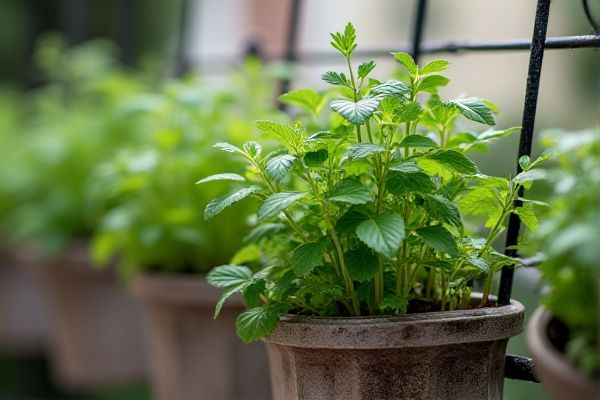
Hanging herb gardens save space by utilizing vertical areas, making them ideal for small balconies or patios, while railing herb planters offer stability and easy access for daily harvesting. Discover which option suits your gardening needs best by reading the rest of the article.
Table of Comparison
| Feature | Hanging Herb Garden | Railing Herb Planter |
|---|---|---|
| Installation | Suspended from ceiling or hooks | Mounted directly onto balcony or deck railings |
| Space Efficiency | Utilizes vertical overhead space | Uses horizontal railing space |
| Sunlight Exposure | Adjustable height for optimal light | Fixed height, depends on railing location |
| Plant Variety | Supports lightweight, small to medium herbs | Accommodates larger pots and multiple plants |
| Water Drainage | Requires drip trays or careful watering | Usually designed with drainage holes |
| Maintenance | Harder to access for watering and pruning | Easy to reach for care and harvesting |
| Durability | Dependent on hooks and suspension strength | Stable and securely attached to railing |
| Aesthetic Appeal | Creates a floating garden effect | Adds greenery along balcony edges |
| Best Use | Small spaces maximizing vertical area | Balconies or decks with railings and limited floor space |
Introduction to Vertical Herb Gardening
Vertical herb gardening maximizes limited space by allowing herbs to grow upward, making it ideal for urban balconies and small patios. Hanging herb gardens create a dynamic, eye-level display that enhances air circulation and sunlight exposure for healthier plants. In contrast, railing herb planters securely attach to balcony edges, optimizing space without sacrificing accessibility or aesthetic appeal.
What is a Hanging Herb Garden?
A hanging herb garden is a space-saving way to grow fresh herbs suspended from ceilings or walls, allowing easy access and efficient use of vertical space. Unlike railing herb planters, which attach directly to balcony or deck railings, hanging gardens provide greater flexibility in placement and can enhance indoor or outdoor aesthetics. Your choice between these options depends on available space and preferred herb varieties, with hanging gardens offering portable green solutions ideal for compact areas.
Overview of Railing Herb Planters
Railing herb planters are designed to securely attach to outdoor railings, maximizing space efficiency on balconies or decks while providing optimal sunlight exposure for various herbs such as basil, mint, and rosemary. These planters typically feature durable materials like weather-resistant plastic or metal with built-in drainage systems to ensure proper root aeration and prevent waterlogging. Their compact and secure design allows for easy maintenance and harvesting, making them ideal for urban gardeners seeking a convenient and attractive solution for growing fresh herbs.
Space Efficiency: Comparing Both Options
Hanging herb gardens maximize vertical space, making them ideal for small balconies or limited outdoor areas where floor space is scarce. Railing herb planters attach directly to balcony rails, utilizing unused horizontal spaces without encroaching on walkways or seating areas. You can choose based on your space constraints and aesthetic preferences to optimize your herb-growing setup effectively.
Installation and Setup Differences
Hanging herb gardens require secure ceiling hooks or wall brackets for installation, often demanding more complex mounting and weight support considerations compared to railing herb planters, which attach directly to balcony or deck railings using adjustable clamps or brackets. Setup for hanging gardens involves ensuring proper height and spacing to allow sunlight and air circulation, while railing planters offer easier repositioning and access, ideal for optimizing growing conditions on limited outdoor spaces. Choosing between the two depends on your available installation points and the level of maintenance convenience you prefer.
Accessibility and Maintenance Needs
A railing herb planter offers easier accessibility for watering and harvesting since it is positioned at waist height, reducing the need to bend or reach awkwardly. Hanging herb gardens often require more effort for regular maintenance, such as trimming and watering, due to their elevated placement. Your choice depends on how much time and effort you can dedicate to herb care while considering ease of access.
Aesthetic Appeal in Balcony and Patio Spaces
Hanging herb gardens create a vertical, space-saving display that enhances balcony and patio aesthetics by adding lush greenery above eye level, offering a dynamic and natural focal point. Railing herb planters provide a neat, organized arrangement along edges, blending functionality with visual appeal by showcasing herbs at hand height without cluttering floor space. Both options elevate outdoor areas, but hanging gardens emphasize height and visual interest, while railing planters prioritize accessibility and structured charm.
Plant Growth and Sunlight Considerations
Hanging herb gardens provide excellent air circulation around plants, promoting healthy growth, while railing herb planters can sometimes restrict airflow but offer more stability. You should consider that hanging gardens typically receive more consistent sunlight from all angles, whereas railing planters may experience partial shading depending on their placement. Optimal plant growth depends on positioning your herbs to maximize exposure to at least 6 hours of sunlight daily.
Cost Comparison: Hanging vs. Railing Planters
Hanging herb gardens typically cost between $15 to $50 depending on materials such as metal or plastic, while railing herb planters range from $20 to $70 due to their specialized design for secure balcony mounting. Installation expenses for hanging gardens are generally lower, often requiring only hooks or ceiling anchors, whereas railing planters may need clamps or brackets, slightly increasing overall costs. Maintenance costs remain comparable for both, but railing planters can offer better plant stability, potentially reducing replacement frequency and long-term expenses.
Which Herb Garden is Right for You?
Hanging herb gardens maximize vertical space and offer a unique aesthetic, ideal for small balconies or patios where floor space is limited. Railing herb planters securely attach to balcony or deck railings, providing easy access and better sunlight exposure for sun-loving herbs. Choose a hanging garden for decorative flexibility and compact areas, while railing planters suit those seeking durability and efficient use of railing space for fresh herbs.
 homyna.com
homyna.com